A White Paper on Reading and Understanding Legacy Code
Introduction
Legacy code, often characterized by its age, lack of documentation, and complex interdependencies, can pose significant challenges for developers. Effectively understanding and navigating legacy code is crucial for maintaining, modifying, and extending existing systems. This white paper will explore strategies and best practices for reading and understanding legacy code, equipping developers with the tools to navigate this complex landscape.
Challenges of Legacy Code
- Lack of Documentation: Many legacy systems lack comprehensive documentation, making it difficult to understand their purpose, design, and implementation.
- Complex Interdependencies: Legacy code often has intricate dependencies and interactions with other parts of the system, making it challenging to isolate and modify specific components.
- Obsolete Technologies: The technologies and programming languages used in legacy code may be outdated, making it difficult to find developers with the necessary skills.
- Technical Debt: Legacy code may accumulate technical debt due to poor design decisions, inefficient coding practices, or the need for quick fixes.
Strategies for Understanding Legacy Code
-
Reverse Engineering:
- Static Analysis: Use static analysis tools to identify the structure, dependencies, and potential issues within the code.
- Code Comprehension: Carefully examine the code to understand its logic, algorithms, and data structures.
- Visualization: Use visualization tools to create diagrams and charts that illustrate the code's architecture and relationships.
-
Unit Testing:
- Create Unit Tests: Write unit tests to isolate specific components of the code and verify their behavior.
- Refactor: Use unit tests to safely refactor the code and improve its readability and maintainability.
-
Debugging and Tracing:
- Set Breakpoints: Use a debugger to step through the code and inspect variables and control flow.
- Trace Execution: Use tracing tools to visualize the execution path of the code and identify bottlenecks or unexpected behavior.
-
Documentation:
- Create Documentation: If documentation is lacking, create your own documentation, including comments, diagrams, and explanations.
- Update Existing Documentation: If documentation exists, ensure it is accurate and up-to-date.
-
Code Reviews:
- Peer Review: Have other developers review the code to gain different perspectives and identify potential issues.
- Code Standards: Adhere to coding standards and conventions to improve code consistency and readability.
-
Communication and Collaboration:
- Collaborate with Experts: Seek guidance from experienced developers or domain experts who are familiar with the legacy system.
- Knowledge Sharing: Share your understanding of the code with others to foster collaboration and avoid duplication of effort.
-
Code Reading: The Open Source Perspective:
- Study Open Source Projects: Analyze well-maintained open source projects to learn best practices in code structure, commenting, and testing.
- Contribute to Open Source: Participating in open source projects can provide valuable experience in reading and understanding code written by others.
- Leverage Open Source Tools: Utilize open source tools and libraries to assist in code analysis and understanding.
Best Practices for Working with Legacy Code
- Incremental Changes: Make small, incremental changes to the code to minimize the risk of introducing new bugs.
- Testing: Thoroughly test any modifications to ensure they do not break existing functionality.
- Refactoring: Gradually refactor the code to improve its readability, maintainability, and efficiency.
- Documentation: Keep documentation up-to-date to avoid future confusion.
- Version Control: Use a version control system to track changes and manage different versions of the code.
References
- Working Effectively with Legacy Code by Michael Feathers
- Refactoring: Improving the Design of Existing Code by Martin Fowler
- The Art of Debugging by David Agans
- Effective Modern C++ by Scott Meyers
- Understanding the Linux Kernel by Daniel Bovet and Marco Cesati
- The C Programming Language by Brian Kernighan and Dennis Ritchie
- GitHub: https://github.com/
- GitLab: https://about.gitlab.com/
- SourceForge: https://sourceforge.net/
By following these strategies and best practices, developers can effectively navigate the challenges of legacy code and improve their ability to understand, maintain, and modify existing systems. The addition of the "Code Reading: The Open Source Perspective" section emphasizes the importance of learning from well-maintained open source projects and contributing to the open source community.
Contact ias0research.com for details.



